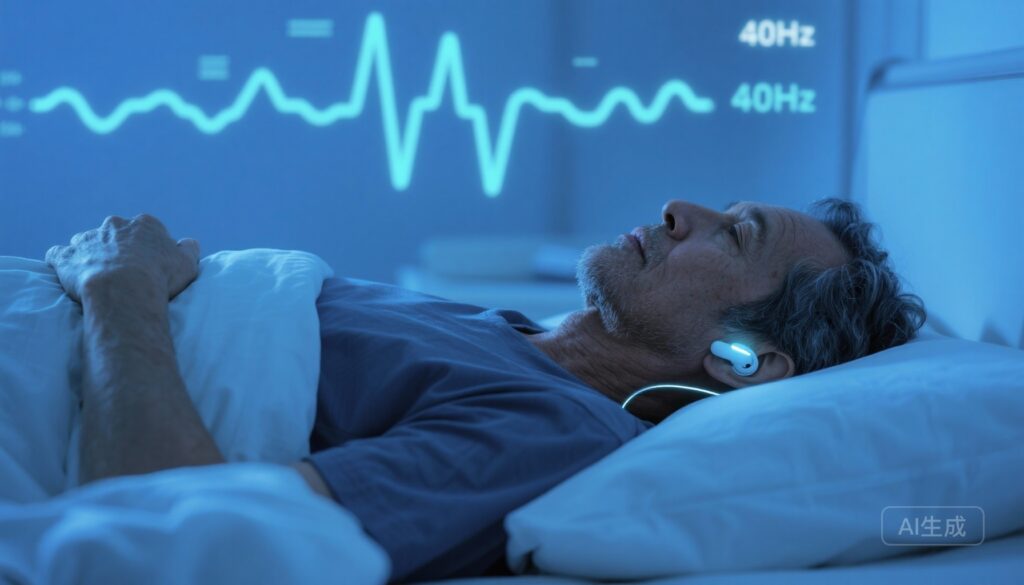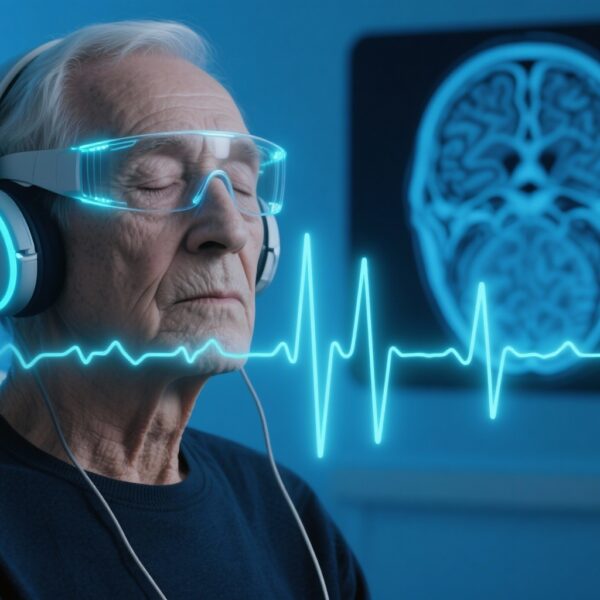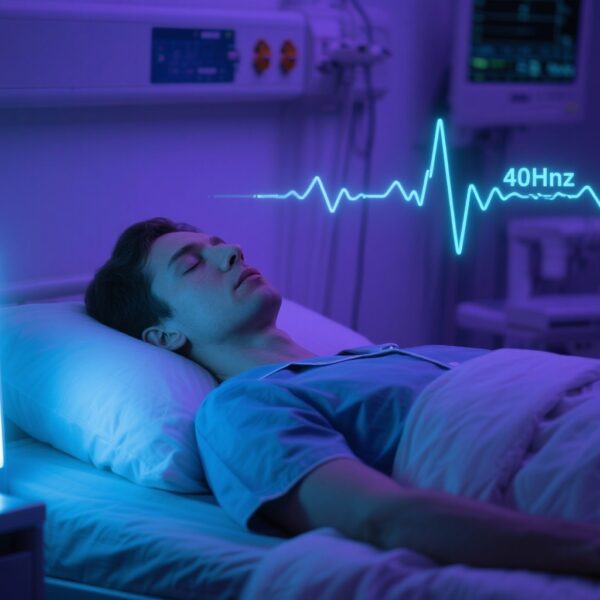Highlight
– A prospective observational study (n=37) exposed adults with insomnia to daily 40 Hz light-and-sound flicker for 8 weeks; mean adherence was 92.2% and no severe adverse events were reported.
– Sleep-diary data reported reductions in sleep onset latency and nocturnal arousals and increases in total sleep time after gamma flicker exposure.
– Findings are hypothesis-generating: they support biological plausibility but are limited by small sample size, lack of a control or sham condition, and reliance on subjective outcome measures.
Background and clinical context
Insomnia—characterized by difficulty initiating or maintaining sleep, or nonrestorative sleep despite adequate opportunity—is highly prevalent and associated with increased risk of cardiovascular disease, mood disorders, cognitive impairment, and reduced quality of life. Clinical guidelines from major bodies recommend cognitive behavioral therapy for insomnia (CBT‑I) as first‑line therapy; pharmacologic and other nonpharmacologic options are used when CBT‑I is unavailable or ineffective (Qaseem et al., Ann Intern Med 2016). There is ongoing interest in novel, nonpharmacologic neuromodulatory approaches that could enhance sleep without systemic side effects.
Gamma‑frequency neural oscillations (~30–100 Hz, typically 40 Hz is studied) are implicated in attention, perception, and memory. In preclinical models, externally driven 40 Hz sensory stimulation entrains cortical networks and has been linked to neuroimmune changes in Alzheimer disease models (Iaccarino et al., Nature 2016; Martorell et al., Cell 2019). Translating sensory gamma entrainment to human therapeutic use has prompted small safety and feasibility studies in neurodegenerative disease. Whether sensory 40 Hz stimulation can meaningfully improve sleep in primary insomnia has been less well characterized.
Study design
Liu et al. (Int J Neurosci. 2025 Sep;135(9):1023–1033) conducted a prospective observational study in 37 participants with insomnia. Key design features reported by the authors include:
- Population: Adults meeting criteria for insomnia (detailed diagnostic criteria not reported in the summary available here).
- Intervention: Daily gamma sensory flicker delivered via a combined light-and-sound device set to 40 Hz. Participants used the device over an 8‑week exposure period.
- Endpoints and assessment: Primary outcomes were feasibility/adherence and safety. Sleep outcomes were assessed by participant sleep diaries (sleep onset latency, number of nocturnal arousals, total sleep time). No polysomnography (PSG) or actigraphy is reported in the available summary.
- Comparator: None (single‑arm observational cohort).
Key results
Adherence and safety:
- Average adherence during the main study phase was reported as 92.21%, indicating participants were able to use the light-and-sound device with high compliance over 8 weeks.
- No severe adverse events attributable to the gamma flicker were reported. The authors did not report serious ocular, auditory, seizure, or psychiatric adverse events in the available summary. Mild transient symptoms (if any) were not detailed here.
Sleep outcomes (sleep diaries):
- Participants’ sleep diaries suggested improvements in sleep quality characterized by reductions in sleep onset latency (time to fall asleep), fewer nocturnal arousals, and increases in total sleep time over the treatment period.
- The authors conclude that 40 Hz flicker “can enhance sleep quality” in people with insomnia based on these diary data.
Interpretation of effect size and statistical significance: The study report summarized here does not provide numeric effect sizes, confidence intervals, or p‑values for diary-derived changes, limiting evaluation of clinical magnitude and precision. The absence of a control or sham comparison prevents attribution of the effects to the 40 Hz stimulation rather than placebo, expectancy, behavioral changes, regression to the mean, or other non‑specific factors.
Why the findings are biologically plausible
Gamma oscillations are involved in cortical synchrony and sleep regulation interfaces. Animal and human research suggests that exogenous rhythmic sensory stimulation can entrain neural oscillations and influence network-level activity (Buzsáki & Wang, Annu Rev Neurosci 2012). Preclinical studies demonstrated that 40 Hz stimulation modulates microglial activity and amyloid pathology in mice (Iaccarino et al., Nature 2016; Martorell et al., Cell 2019), and early human work has shown that 40 Hz sensory stimulation can induce measurable EEG entrainment without major safety signals in small samples. Modulation of cortical synchrony in the gamma band could conceivably alter arousal systems or sleep architecture, providing a mechanistic rationale for sleep improvement.
Strengths of the study
- Prospective, real‑world exposure over a clinically relevant duration (8 weeks).
- High participant adherence suggests acceptability of the intervention.
- No serious safety signals reported in this cohort, which is important for light‑ and sound‑based interventions that could theoretically provoke headaches, dizziness, or photosensitive events.
Key limitations and sources of bias
- No control or sham arm: Without randomization and blinding, placebo effects and expectation can substantially influence subjective sleep reports.
- Small sample size (n=37) limits precision and subgroup analysis and increases risk that results are driven by outliers.
- Outcome measures were solely subjective (sleep diaries): objective verification with PSG or actigraphy was not reported, so effects on sleep architecture, sleep efficiency, or wake after sleep onset are unknown.
- Details on participant selection and diagnostic rigor for insomnia (duration, insomnia subtypes, comorbid psychiatric or medical conditions, concurrent medications) were not provided in the summary; these factors affect generalizability and safety.
- Dose, timing, and parameters of stimulation (session length, time relative to bedtime, light intensity, sound amplitude) were not fully described here; these are critical for replication and dose‑response study design.
Clinical implications
For clinicians treating insomnia, this study should be viewed as preliminary, hypothesis‑generating evidence that 40 Hz sensory flicker is acceptable and tolerable for motivated patients and may be associated with improved subjective sleep. It does not yet provide a high enough level of evidence to recommend routine clinical use in place of established therapies such as CBT‑I or appropriately indicated pharmacotherapy. However, for patients who decline medication and cannot access CBT‑I, an investigational, device‑based approach with demonstrated adherence and no serious safety signals could be discussed with clear counseling about the limited evidence base and lack of controlled data.
What further research is needed
To evaluate the therapeutic potential of gamma sensory flicker for insomnia, the research agenda should include:
- Randomized, double‑blind, sham‑controlled trials to establish efficacy versus placebo and to quantify effect sizes and durability.
- Objective sleep measurement (polysomnography, actigraphy) to determine effects on sleep architecture, sleep efficiency, wake after sleep onset, and spectral EEG changes (entrainment) during and after stimulation.
- Dose‑finding studies examining frequency (40 Hz vs other bands), intensity, session duration, and timing relative to circadian phase, as well as short‑ and long‑term safety monitoring.
- Subgroup analyses to identify which insomnia phenotypes (e.g., sleep‑onset vs sleep maintenance; comorbid psychiatric illness; older adults) may benefit most.
- Mechanistic studies using concurrent EEG/fMRI where feasible to map neural entrainment, arousal system modulation, and downstream effects on sleep‑regulatory circuits.
Expert commentary and context
Experts in sleep and neuromodulation view gamma entrainment as an intriguing translational pathway from basic neuroscience to clinical therapeutics. The preclinical data supporting network‑level modulation at 40 Hz is robust, but human translation has historically required rigorous randomized trials because subjective outcomes are vulnerable to bias. The high adherence and lack of severe events reported by Liu et al. are encouraging and align with early feasibility work in neurodegeneration, but efficacy must be confirmed under blinded conditions. Until randomized data are available, mainstream recommendations such as CBT‑I remain standard of care (Qaseem et al., 2016).
Conclusion and takeaways
Liu et al. report that 8 weeks of daily 40 Hz light-and-sound flicker was feasible, well tolerated, and associated with subjective improvements in sleep diary measures among 37 adults with insomnia. The results provide a plausibility signal and support further investigation, but the study’s single‑arm design, small size, and reliance on subjective outcomes mean that the findings should be considered preliminary. Rigorous sham‑controlled randomized trials with objective sleep endpoints and mechanistic measurements are required before gamma sensory flicker can be recommended as a treatment for insomnia.
Funding and clinicaltrials.gov
The provided study citation (Liu Y et al., Int J Neurosci. 2025) did not report funding sources or a clinicaltrials.gov registration number in the summary available for this analysis; readers should consult the full published manuscript for trial registration, funding declarations, and conflict‑of‑interest disclosures.
Selected references
1. Liu Y, Li X, Liu S, Liang T, Wu Y, Wang X, Li Y, Xu Y. Study on Gamma sensory flicker for Insomnia. Int J Neurosci. 2025 Sep;135(9):1023-1033. doi: 10.1080/00207454.2024.2342974. Epub 2024 Apr 25. PMID: 38629395.
2. Iaccarino HF, Singer AC, Martorell AJ, et al. Gamma frequency entrainment attenuates amyloid load and modifies microglia. Nature. 2016;540(7632):230-235.
3. Martorell AJ, Paulson AL, Suk HJ, et al. Multi-sensory Gamma Stimulation Ameliorates Alzheimer’s-Associated Pathology and Improves Cognition. Cell. 2019;177(2):256-271.e22.
4. Qaseem A, Kansagara D, Forciea MA, Cooke M, Denberg TD; Clinical Guidelines Committee of the American College of Physicians. Management of Chronic Insomnia Disorder in Adults: A Clinical Practice Guideline From the American College of Physicians. Ann Intern Med. 2016;165(2):125-133.
5. Buzsáki G, Wang XJ. Mechanisms of gamma oscillations. Annu Rev Neurosci. 2012;35:203-225.
Author note
This article is a critical synthesis of the available information from Liu et al. (2025) combined with prior mechanistic and clinical literature. It is intended for clinicians and researchers evaluating neuromodulatory approaches to insomnia and does not constitute clinical guidance. For clinical decisions, refer to the primary study, guideline statements, and patient‑specific factors.



